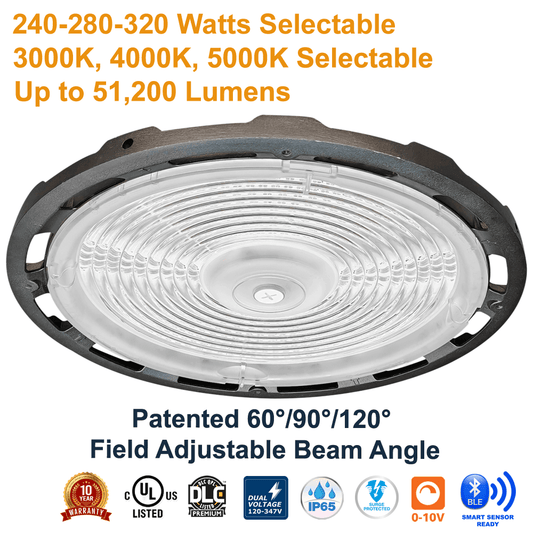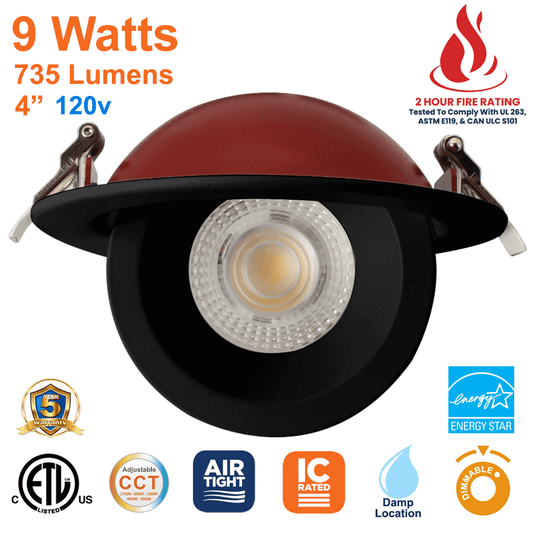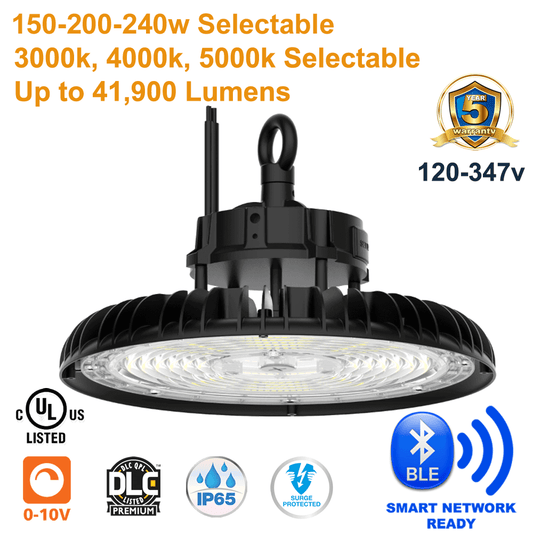In the world of Commercial LED Lighting, the ability to control an LED fixture’s brightness is one of today’s most in-demand features. Dimming LED Panel Lights, especially in commercial and industrial settings, creates better ambiance, saves energy, and extends the lifespan of the fixtures.
Most LED Panel Lights now come with 0-10v Dimming Drivers. But the question still remains “how do I use 0-10v dimming on my LED Panel Lights?” Before we give away the ultimate secret of how to easily dim your LED Panel Lights, let’s take a look at 0-10v dimming and discover the magic behind it.
What is 0-10v Dimming?
0-10v dimming is a tried and true method used in LED Lighting systems. It's a standard protocol where a control signal varies between 0 volts (fully off) and 10 volts (fully on). This range allows for a smooth and consistent dimming curve. For a deeper understanding, our recent article provides an updated overview of 0-10v dimming in 2023.
"Dimming LED Panel Lights in commercial and industrial settings creates better ambiance, saves energy, and extends the lifespan of the fixtures."
How Does 0-10v Dimming Work?
At its core, 0-10v dimming involves two main components: the LED Driver and the dimmer switch. The LED driver receives the voltage signal from a dimmer switch, APP control, or daylight harvesting sensor. which then adjusts the output current to the LED light, thus controlling its brightness. The beauty of this system lies in its simplicity and effectiveness, making it a popular choice for Office Lighting and other commercial spaces.
Benefits of Dimming an LED Panel Light
Dimming isn't just about setting the mood. Here are some compelling reasons to consider dimming your LED Panel Lights:
- Energy Efficiency: Dimmed lights consume less power, leading to significant energy savings.
- Extended Lifespan: Dimming can extend the life of an LED fixture, as they experience less thermal stress.
- Enhanced Comfort: Adjusting brightness can reduce glare and create a more comfortable environment, especially in areas with Drop Ceiling Lights.
Networked Lighting Controls - Making LED Panel Light Dimming Easy
Enter the realm of Wireless Networked Lighting Controls (NLCs). NLCs deliver centralized control of lighting fixtures, enabling users to adjust brightness, color temperature, and even set schedules. One standout product in this category is the Keilton PPA102S Networked Lighting Controller. This Bluetooth Mesh controller seamlessly integrates onto an LED Panel Light, offering a range of control options.
Installing the Keilton PPA102S
Installation of the Keilton PPA102S is straightforward and quick. Attach it on the fixture’s driver junction box, at one of the knockouts, and make the connections shown in the wiring diagram below.
Keilton's PPA102S controller works on 120-277v power, a 347v model is being introduced in Q4 of 2023. Until then, for 347v applications, install a stepdown transformer on the fixtures driver junction box to reduce the voltage.
Once connected to an LED Panel Light, the controller communicates with other devices in the network, allowing for centralized control. This integration is especially beneficial for open office lighting setups, where large areas need consistent lighting conditions.
The Keilton WP1025 Wireless Switch
Another gem from the world of Networked Lighting Controls is the Keilton WP1025 Wireless Switch. This 5-key switch offers on/off, dimming, and control over 3 lighting scenes, making adjustments a breeze. The switch is mirrored in the Keilton APP, so lighting adjustments can be made while still seated at a desk.
In the next segment, we'll further explore the advantages of Wireless Networked Lighting Controls and how they can be used to create significant energy savings. We'll also highlight more groundbreaking products, available from LED Network’s Lighting Store, that are reshaping the Commercial Lighting landscape.
The Power of Wireless Networked Lighting Controls
In today's fast-paced world, the demand for efficient and smart lighting solutions is on the rise. This is where Wireless Networked Lighting Controls come into play, offering a blend of convenience, efficiency, and innovation. Let's take a deeper look at the world of these controls and how they're revolutionizing the Commercial Lighting and Industrial Lighting sectors.
Beyond Dimming: The Multifaceted Benefits
While dimming LED Panel Lights is a significant advantage, Wireless Networked Lighting Controls offer multiple other benefits:
- Flexibility: With wireless controls, you can manage lighting from anywhere the system is connected to. This can be in the room you’re controlling, or even a remote location.
- Energy Savings: Automated schedules and occupancy sensors ensure lights are only on when needed, leading to substantial energy savings.
- Enhanced Safety: Features like daylight harvesting and motion sensors can adjust lighting based on natural light availability and occupancy, ensuring well-lit spaces at all times.
The Keilton WP1025: More Than Just a Switch
The Keilton WP1025 Wireless Switch is a testament to the advancements in Networked Lighting Controls. Beyond its primary function of dimming, it offers:
- Scene Setting: Create and recall customized lighting scenes for different activities or times of the day.
- Group Control: Manage multiple lights simultaneously, ensuring uniform brightness levels across spaces.
- Timer Functions: Set schedules for automatic on/off or dimming, optimizing energy usage.
- Battery Powered Flexibility: Using the WP Faceplate the switch can be placed anywhere in a room. As the WP1025 is battery powered, it doesn’t have to be connected to a power source.
How Wireless Networked Lighting Controls Save Money
It's not just about ambiance or convenience; it's also about the bottom line. Implementing Networked Lighting Controls can lead to significant cost savings:
- Reduced Energy Bills: By ensuring lights are only used when necessary, energy consumption drops, reflecting in lower utility bills.
- Extended Light Lifespan: Dimming and reduced usage will extend the life of LED Panel Lights, decreasing replacement costs.
- Maintenance Savings: With features like real-time monitoring and alerts, potential issues can be addressed promptly, reducing maintenance costs.
A Glimpse into the Future: Bluetooth Low Energy
One of the driving forces behind the success of Networked Lighting Controls is Bluetooth Low Energy (BLE). Our insightful article sheds light on how BLE is revolutionizing Networked Lighting Controls, offering greater communication range, lower power consumption, and enhanced security.
In the concluding segment, we'll focus on the installation process of the Keilton PPA102S Networked Lighting Controller and how it seamlessly integrates with LED Panel Lights. We'll also touch upon the broader implications of integrating Networked Lighting Controls in commercial and industrial settings. Stay tuned!
Seamless Integration: The Keilton PPA102S and Modern LED Panel Lights
The future of Commercial Lighting and Industrial Lighting is not just about illumination—it's about intelligent control, adaptability, and maximizing efficiency. At the heart of this evolution are Networked Lighting Controllers, like the Keilton PPA102S. Let's review the installation process and the broader implications of integrating these advanced controls.
Installing the Keilton PPA102S: A Step-by-Step Guide
The Keilton PPA102S Networked Lighting Controller is designed for user-friendly installation:
- Safety First: Before starting, ensure the power to the LED Panel Light is turned off to prevent any electrical mishaps.
- Connection: Connect the controller to the LED Panel Light using the provided connectors (use the wiring diagram shown earlier in this article). Ensure the wires are securely attached.
- Configuration: Once connected, power on the system. Using the Keilton APP, configure the controller to communicate with other devices in the network.
- Testing: Test the controller's functionality, ensuring it can dim the LED Panel Light and communicate with other devices seamlessly.
The Broader Implications
Integrating Keilton’s PPA102S and similar Networked Lighting Controls into commercial and industrial spaces has several advantages:
- Centralized Control: Manage all lighting fixtures from a single point, ensuring uniformity and optimal lighting conditions.
- Data Collection: These controls can gather data on usage patterns, helping businesses make informed decisions about energy consumption.
- Sustainability: With the global push towards sustainability, using Networked Lighting Controls can significantly reduce a facility's carbon footprint.
Beyond Lighting: The World of Networked Controls
While the primary focus has been on dimming LED Panel Lights, the realm of Networked Lighting Controls extends far beyond. From occupancy sensors to daylight harvesting, these systems offer a suite of features that can transform any space. Our dedicated blog offers a deep dive into the myriad benefits of these controls.
In conclusion, dimming LED Panel Lights is more than just setting the right ambiance—it's about embracing the future of lighting, and it’s easy to do. With advanced products like the Keilton PPA102S and the broader capabilities of Networked Lighting Controls, businesses can not only save money but also step into a brighter, more sustainable future. LED Network is at the forefront of this revolution, offering cutting-edge solutions for every lighting situation.


























